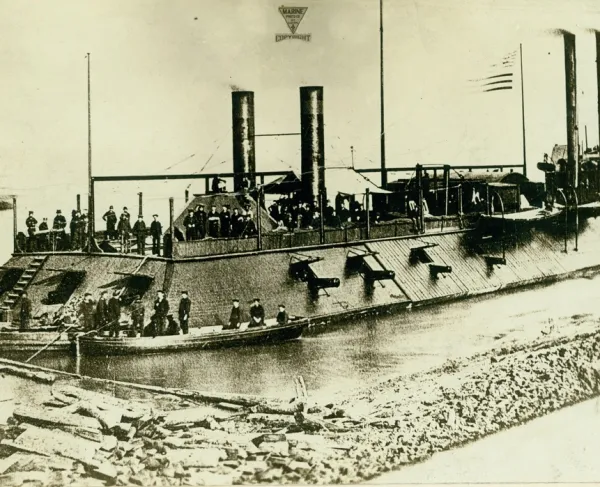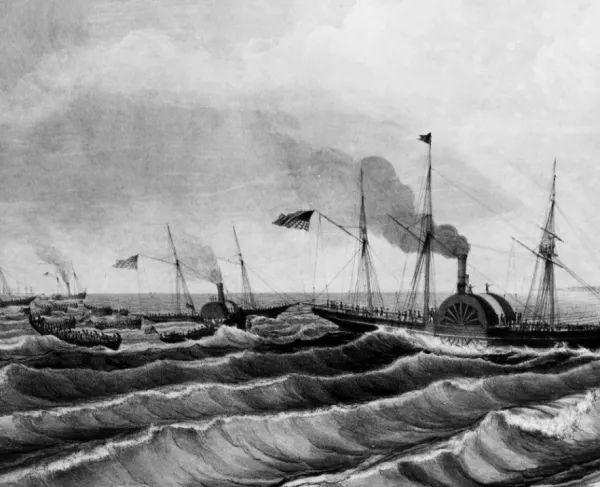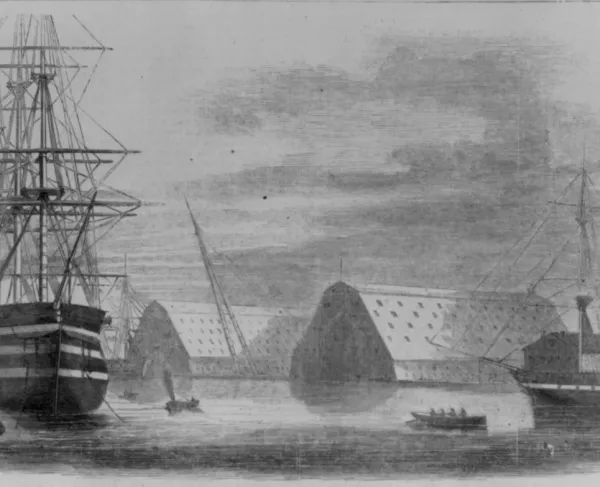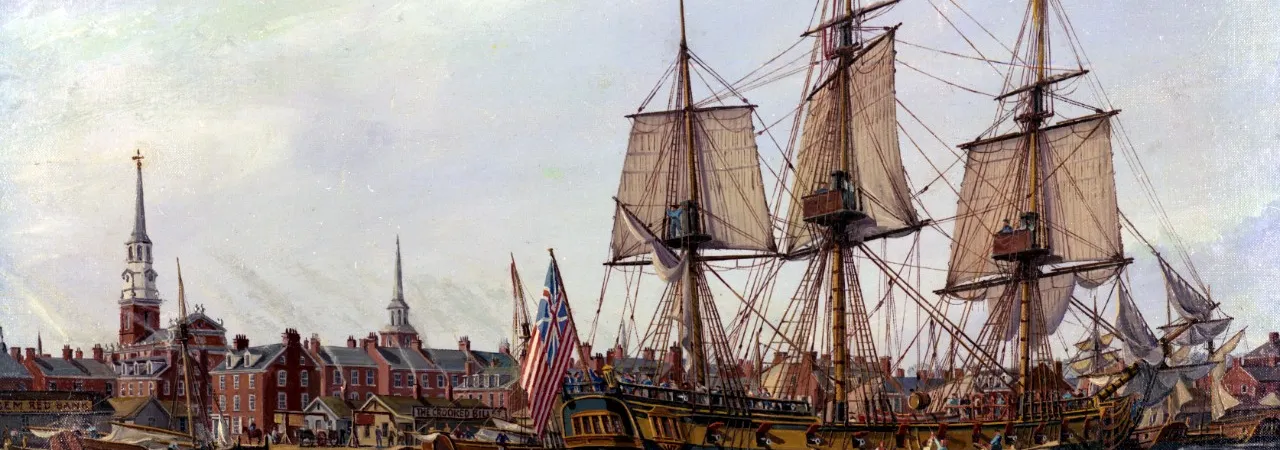
Continental ships in Philadelphia by N. Nowland Van Powell
Navies have always played a large role in both maritime trade and warfare. They protect trade routes for their merchants’ vessels from pirates, privateers, and hostile nations. They also fight battles on the sea in times of war or transporting troops to the battlefield. In the 18th century, the Royal Navy is the largest and most advanced fleet in the world. When the American Revolution begins, many Royal Navy ships are sent to the Americas to help subdue the rebellion. The Patriot cause will need a navy of their own.
The earliest naval action of the American Revolution will take place shortly after the Battle of Lexington and Concord. This is done by individual colonies, arming small vessels for the purpose of protection of local maritime commerce. When General Washington takes command of the Continental Army in July 1775, he finds his troops lacking ammunition and gunpowder. He dispatches a ship from the Rhode Island Navy to sail to Bermuda for supplies and soon outfits seven small vessels to interfere with British supply ships. With Commodore John Manly in command, this small fleet captured one British ship with a quantity of gunpowder equivalent to eighteen months of the manufacturing capacity of the colonies. In the fall of 1775, it is clear that to win a war against the British, the Continental Congress would have to form a navy.
On October 13th, 1775, Congress votes to fit ships for the purpose of naval warfare; thus, the Continental Navy is born. Coming with this vote, Congress also creates an advisory committee consisting of three men, John Langdon, Silas Deane, and John Adams. The committee first suggests attacking British ships for the purpose of securing supplies and the small vessels outfitted to do so find immediate success. But Congress doesn’t stop there, they truly commit to naval expansion in three keyways. First, they authorize the purchase of four ships of war, second, they enlarge the Naval Committee to seven men and third, it extends the committee’s brief to building naval forces south on New England waters, all the way to Georgia. These plans are enhanced when in November, word reaches the colonies that Congress’s last-ditch effort at peace with the Crown, the Olive Branch Petition, is denied by King George III and the colonies are truly in open rebellion. By the end of 1775, Congress passes a series of resolutions to purchase more ships, allocate funds to the naval committee, muster American Marines, and approve a set of rules and regulations for their navy.
Esek Hopkins accepts command of the first Continental fleet outfitting in Philadelphia on December 22, 1775 and serves with success until he is dismissed from the navy in 1778. Early in and throughout the war, Congress declares all British vessels fair game for capture and authorizes privateering. Privateering plays a large part in 18th century naval warfare and nearly all countries utilize it; privateers, using privately owned ships, are given commissions or contracts by a country to freely attack another. Congress uses privateers to assist the small Continental Navy to conduct the goals given by the committee.
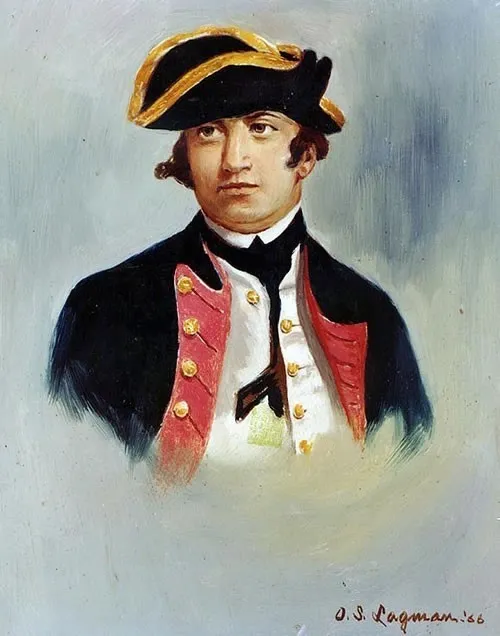
Throughout the course of the war, a total of around sixty vessels of various size serve in the Continental Navy. These ships are either newly built, converted, loaned, or captured. In 1777, the navy peaked at thirty-one vessels. This may seem like a decent number, however, at the beginning of the war the British Royal Navy has around two hundred and fifty vessels of various size and this number doubles by the end of the American Revolution. The Continentals can never hope to defeat the much larger Royal Navy in open combat on the seas, so they, along with their privateers, result to attacking merchant and smaller vessels. Just like the first raid dispatched by General Washington, these ships capture much needed supplies and harm British merchants.
Among the vessels that have success, the most notorious captains among them is John Paul Jones. A native of Scotland, Jones joins the Continental Navy in its earliest days. Beginning with raiding British ships in American waters, he soon sails across the Atlantic and raids shipping in the British Isles. He is so successful that British mothers use Jones’ name to scare their children into good behavior. His raids are made easier as France joins the war on the Continental side, using French harbors as his jumping off point.
Though the Continental Navy is great at raiding commerce home and abroad, they still can’t hope to make a large impact on the ground war in the colonies. The Royal Navy made it possible for the British army to force surrender at Savannah, Charleston, and Wilmington, as well as ravaging the coast of Connecticut and burning several cities elsewhere. When France joins the war in 1778, they have the ability to provide naval forces that can compete with the Royal Navy. Washington realizes that to truly win this war of independence, he needs a superior fleet and constantly urges Benjamin Franklin, who is in Paris representing the American government, that he needs French ships much more than French troops. The French did send ships to the American colonies but also elsewhere in the world to contest the Royal Navy. Spain joins the war on the Continental side in 1779, which forces the Royal Navy to stay closer to the home isles in case of a combined Spanish-Franco invasion. Most importantly, this takes some pressure off of the Continentals from the Royal Navy, but they are still a large threat.
The final showdown comes in September 1781 in the Battle of the Chesapeake off the coast of Virginia. A Royal Navy fleet sails from New York City to the coast of Virginia to aid Lord Cornwallis who is at Yorktown. On the 5th of that month, the fleet of British ships under the command of Admiral Thomas Graves and the French armada under the Comte de Grasse fight a two-hour battle in the Chesapeake Bay. In the end, Graves is forced to break off and return to New York, leaving Cornwallis stranded on the Yorktown Peninsula. Washington is able to force the surrender of the British army at Yorktown on October 19, 1781 and is the last major land engagement of the American Revolution that breaks the political will of the British to continue the war.
With the war over and the Articles of Confederation taking hold in 1781, the Continental Navy becomes unneeded. The Continental Navy is disbanded with many of its vessels sold. When the Constitution is created by the first Congress in 1787, it calls for the creation of army but not a navy. That will change when Barbary pirates wreak havoc on U.S. commerce and Congress passes the Naval Act of 1794, which formally creates the United States Navy. Several people are credited with being the father of the United States Navy but most credit John Paul Jones, who fought so gallantly in the Continental Navy during the American Revolution.

